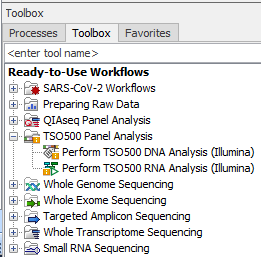TruSight Oncology 500
TruSight Oncology panels
The TruSight Oncology 500 (TSO500) bundle enables analysis of both DNA and RNA in cancer samples and cover a wide range of cancer genes known to host driver mutations as well as fusion genes. The panel has a size that enables analysis of tumor mutational burden (TMB) scores.
Two ready-to-use workflows are available for analyzing TruSight Oncology 500 panels, one for analysis of DNA and one for analysis of RNA (figure 16.1).

Figure 16.1: Two ready-to-use workflows are available for analyzing TruSight Oncology 500 panels; Perform TSO500 DNA Analysis (Illumina) and Perform TSO500 RNA Analysis (Illumina).
The Perform TSO500 DNA Analysis (Illumina) workflow includes somatic variant calling, CNV detection and reporting of a TMB score. The RNA workflow, Perform TSO500 RNA Analysis (Illumina), includes an expression matrix and reporting of detected fusions. Both workflows are configured with hg38 reference data using RefSeq annotations and use a traditional re-sequencing strategy for DNA and RNA sample analysis, respectively.
In both the DNA and the RNA workflow, the reads are initially subjected to the following steps:
- Annotation with UMI information and trimming off the UMI barcode
- Quality trimming to remove low quality bases, adapter read-through and homoploymer regions at the read ends
- Grouping reads into consensus reads based on UMI and sequence similarity
- Mapping the UMI reads to a reference
The DNA analysis is followed by local re-alignment of the reads in the read mapping using a guidance track and variant detection using the Fixed Ploidy Variant Detection tool. The variants are filtered on quality parameters such as QUAL, Average Quality, BaseQRankSum and read direction test probability in different filters focusing on High UMI count, low coverage, BaseQRankSum bias and homopolymer evidence. The read mapping is analyzed for a coverage profile and the somatic variants are further filtered in the Calculate TMB Score tool to evaluate the tumor mutational burden with suitable cutoffs. When a matched normal sample is available or a baseline encompassing between 3 to 5 samples are supplied as controls, CNVs are reported, if present in the sample. Finally, reports are generated by different tools in the workflow, and summaries of these reports are available in a combined report that can be used for quality control. The generated Track list allows for detailed, visual review of the results.
In the RNA workflow, a gene expression track, summarizing the expression at gene-level, and a read mapping is produced by the RNA-seq Analysis tool. The mapped RNA reads are used for fusion gene detection. Detection of fusion genes involves creation of potential fusion chromosomes that are evaluated by a refinement approach where the RNA reads are remapped to a reference that now includes the new potential fusion genes. Finally, analysis reports are generated by different tools in the workflow, and summaries of these reports are available in a combined report that can be used for quality control. Two Track lists are generated, allowing for detailed, visual review of the results, one for the wildtype chromosomes and one for the fusion gene chromosomes.
NOTE: The current workflow is not including tools for MSI detection, as a proper baseline needs to be created for this analysis to report the true identity of MSI status. This is work in progress and the expectation is that this will be provided in a later version.
Subsections
- The Perform TSO500 DNA Analysis (Illumina) workflow
- The Perform TSO500 RNA Analysis (Illumina) workflow
